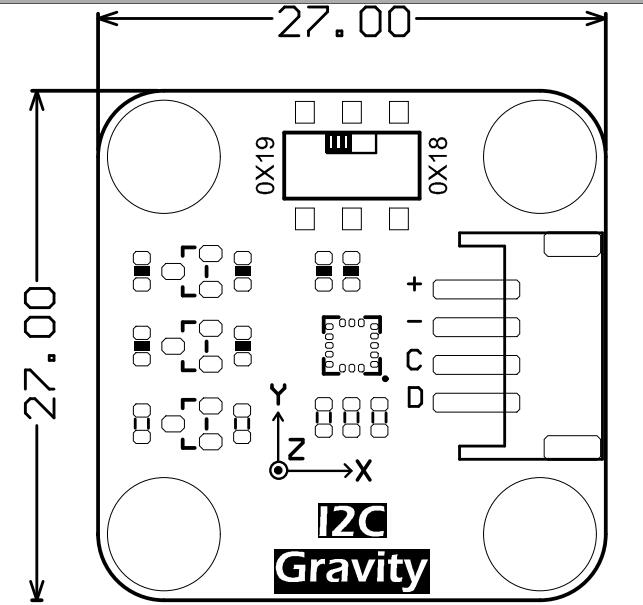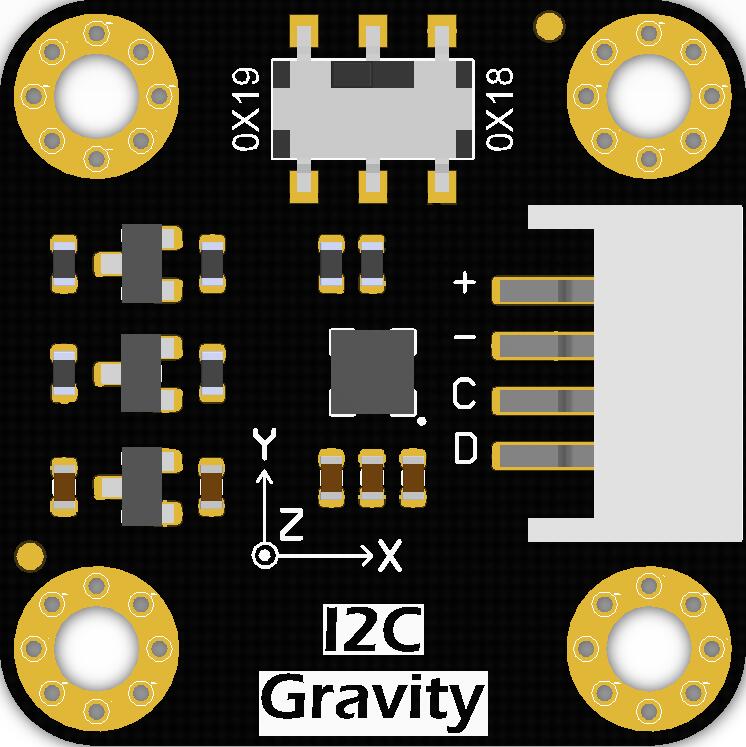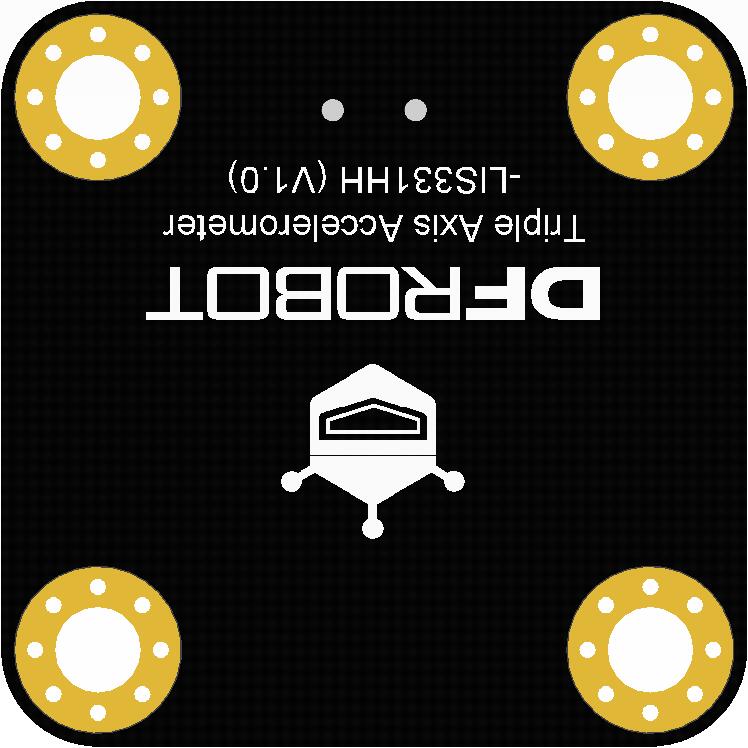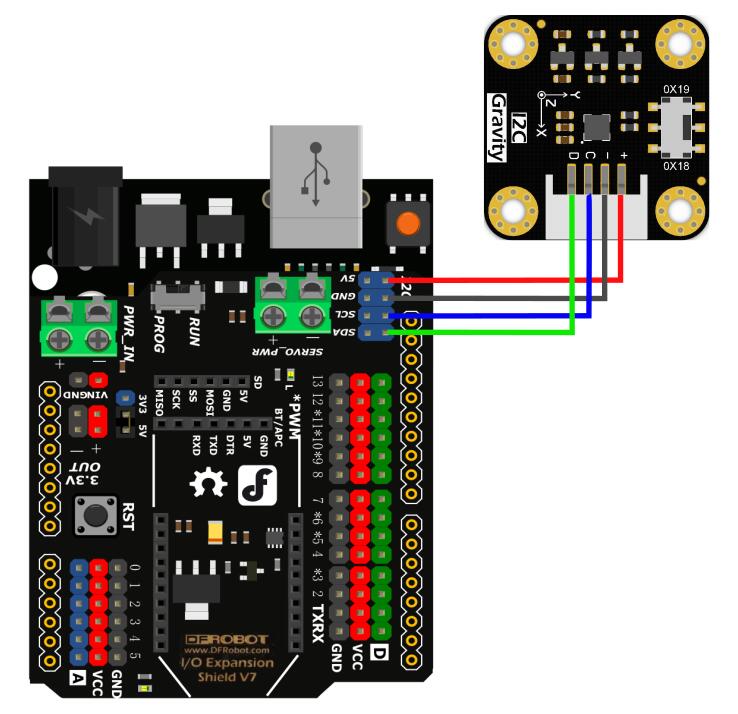Introduction
The LIS331HH is a high-performance 3-axis linear accelerometer with ultra-low power consumption of 10uA. The device features ultra low-power operational modes that allow advanced power saving and smart sleep to wake-up functions. It offers user-selectable scales of ±6g/±12g/±24g and is capable of measuring accelerations with output data rates from 0.5Hz to 1KHz. The sensor is applicable to fields like navigation, smart agriculture, robotics, VR/AR, etc. The device contains 2 indipendent interrupt engines able to recognize dedicated inertial events.
Feature
- Selectable scales: ±6g/±12g/±24g
- Change I2C address by the toggle switch
- Easy-to-use Gravity interface, no need to solder
Specification
- Operating Voltage: 3.3V~5V
- Operating Current: 10uA(low power mode)/0.3mA-0.4mA(Normal mode)
- Interface: Gravity-I2C
- I2C Address: 0x19 (Default)/0x18 (Optional)
- Selectable Scale: ±6g/±12g/±24g
- Frequency: 0.5Hz~1KHz
- 16-bit Data Output
- Operating Temperature: -40℃~+85℃
- 10000g High Shock Survivability
- ECOPACK, RoHS and “Green” compliant
- Module Size: 2727mm/1.061.06”
- Mounting Hole Size: inner diameter 3mm/outer diameter 6mm
Note: The two programmable interrupt pins have not been soldered on Grvaity version of this board. For using advanced functions like external interrupt and sleep-to-wakeup, please purchase the Breakout version.
Application
- Free-fall detection
- Motion activated functions
- Gaming and virtual reality input devices
Board Overview
| Num | Label | Description |
|---|---|---|
| 1 | VCC/+ | 5V / 3V3 |
| 2 | GND/- | GND |
| 3 | SCL/C | I2C Clock Line |
| 4 | SDA/D | I2C Data Line |
Note: you can select I2C address as 0x18 or 0x19 by the toggle switch. The I2C address of the micro:bit V1.5 is conflict with the sensor I2C 0x19, so please select 0x18 when using it with micro:bit V1.5.
Tutorial for Arduino
This product adopts standard Gravity I2C interface, which is very easy to use. You can directly connect the sensor with your UNO(other boards) as the connection diagram shows.
Requirements
-
Hardware
- DFRduino UNO R3 (or similar) x 1
- LIS331HH Triple Axis Accelerometer x1
- Jumper wires
-
Software
- Arduino IDE
- Download and install the LIS Series Library and Sample Code. (About how to install the library?)
Connection Diagram
Sample Code
-
Sample code 1-Read acceleration of x, y and z(getAcceleration.ino)
-
Sample code 2-Wakeup function(wakeUp.ino) (Only available for breakout version)
-
Sample code 3-External Interrupt Function(interrupt.ino) (Only available for breakout version)
-
Main API Function List
DFRobot_LIS();
/**
* @brief Initialize the function
* @return true(Succeed)/false(Failed)
*/
bool begin(void);
/**
* @brief Get chip id
* @return 8 bit serial number
*/
uint8_t getID();
/**
* @brief Enable interrupt
* @param source Interrupt pin selection
eINT1 = 0,/<int1 >/
eINT2,/<int2>/
* @param event Interrupt event selection
eXLowerThanTh ,/<The acceleration in the x direction is less than the threshold>/
eXHigherThanTh ,/<The acceleration in the x direction is greater than the threshold>/
eYLowerThanTh,/<The acceleration in the y direction is less than the threshold>/
eYHigherThanTh,/<The acceleration in the y direction is greater than the threshold>/
eZLowerThanTh,/<The acceleration in the z direction is less than the threshold>/
eZHigherThanTh,/<The acceleration in the z direction is greater than the threshold>/
*/
void enableInterruptEvent(eInterruptSource_t source, eInterruptEvent_t event);
/**
* @brief Set measurement range
* @param range Range(g)
eH3lis200dl_100g, //±100g
eH3lis200dl_200g, //±200g
eLis331hh_6g = 6,//±6g
eLis331hh_12g = 12 //±12g
eLis331hh_24g = 24 //±24g
@return true(Set successfully)/false(Set failed)
*/
bool setRange(eRange_t range);
/**
* @brief Set data measurement rate
* @param rate rate(HZ)
ePowerDown_0HZ //Measurement off
eLowPower_halfHZ //0.5 hz
eLowPower_1HZ
eLowPower_2HZ
eLowPower_5HZ
eLowPower_10HZ
eNormal_50HZ
eNormal_100HZ
eNormal_400HZ
eNormal_1000HZ
*/
void setAcquireRate(ePowerMode_t rate);
/**
* @brief Set data filtering mode
* @param mode Four modes
eCutOffMode1 = 0,
eCutOffMode2,
eCutOffMode3,
eCutOffMode4,
eShutDown, no filering
eg: Select eCutOffMode1 in 50HZ, and the filtered frequency is 1HZ
*|---------------------------High-pass filter cut-off frequency configuration-----------------------------|
*|--------------------------------------------------------------------------------------------------------|
*| | ft [Hz] | ft [Hz] | ft [Hz] | ft [Hz] |
*| mode |Data rate = 50 Hz| Data rate = 100 Hz | Data rate = 400 Hz | Data rate = 1000 Hz |
*|--------------------------------------------------------------------------------------------------------|
*| eCutOffMode1 | 1 | 2 | 8 | 20 |
*|--------------------------------------------------------------------------------------------------------|
*| eCutOffMode2 | 0.5 | 1 | 4 | 10 |
*|--------------------------------------------------------------------------------------------------------|
*| eCutOffMode3 | 0.25 | 0.5 | 2 | 5 |
*|--------------------------------------------------------------------------------------------------------|
*| eCutOffMode4 | 0.125 | 0.25 | 1 | 2.5 |
*|--------------------------------------------------------------------------------------------------------|
*/
void setHFilterMode(eHighPassFilter_t mode);
/**
* @brief Set the threshold of interrupt source 1 interrupt
* @param threshold The threshold we set before is within measurement range(unit:g)
*/
void setInt1Th(uint8_t threshold);
/**
* @brief Set interrupt source 2 interrupt generation threshold
* @param threshold The threshold we set before is within measurement range(unit:g)
*/
void setInt2Th(uint8_t threshold);
/**
* @brief Enable sleep wake function
* @param enable true(enable)\false(disable)
* @return false Indicate enable failed/true Indicate enable successful
*/
bool enableSleep(bool enable);
/**
* @brief Check whether the interrupt event'event' is generated in interrupt 1
* @param event Interrupt event
eXLowerThanTh ,/<The acceleration in the x direction is less than the threshold>/
eXHigherThanTh ,/<The acceleration in the x direction is greater than the threshold>/
eYLowerThanTh,/<The acceleration in the y direction is less than the threshold>/
eYHigherThanTh,/<The acceleration in the y direction is greater than the threshold>/
eZLowerThanTh,/<The acceleration in the z direction is less than the threshold>/
eZHigherThanTh,/<The acceleration in the z direction is greater than the threshold>/
* @return true This event generated
false This event not generated
*/
bool getInt1Event(eInterruptEvent_t event);
/**
* @brief Check whether the interrupt event'event' is generated in interrupt 2
* @param event Interrupt event
eXLowerThanTh ,/<The acceleration in the x direction is less than the threshold>/
eXHigherThanTh ,/<The acceleration in the x direction is greater than the threshold>/
eYLowerThanTh,/<The acceleration in the y direction is less than the threshold>/
eYHigherThanTh,/<The acceleration in the y direction is greater than the threshold>/
eZLowerThanTh,/<The acceleration in the z direction is less than the threshold>/
eZHigherThanTh,/<The acceleration in the z direction is greater than the threshold>/
* @return true This event generated
false This event not generated
*/
bool getInt2Event(eInterruptEvent_t event);
/**
* @brief Get the acceleration in the x direction
* @return acceleration from x
*/
int32_t readAccX();
/**
* @brief Get the acceleration in the y direction
* @return acceleration from y
*/
int32_t readAccY();
/**
* @brief Get the acceleration in the z direction
* @return acceleration from z
*/
int32_t readAccZ();
/**
* @brief Get the acceleration in the three directions of xyz
* @param accx Store the variable of acceleration in x direction
* @param accy Store the variable of acceleration in y direction
* @param accz Store the variable of acceleration in z direction
* @return true(Get data successfully/false(Data not ready)
*/
bool getAcceFromXYZ(int32_t &accx,int32_t &accy,int32_t &accz);
/**
* @brief Get whether the sensor is in sleep mode
* @return true(In sleep mode)/false(In normal mode)
*/
bool getSleepState();
/**
* @brief Set the sleep state flag
* @param into true(Flag the current mode as sleep mode)
false(Flag the current mode as normal mode)
*/
void setSleepFlag(bool into);
Sample code 1-Read acceleration of x, y and z(getAcceleration.ino)
- Select getAcceleration.ino
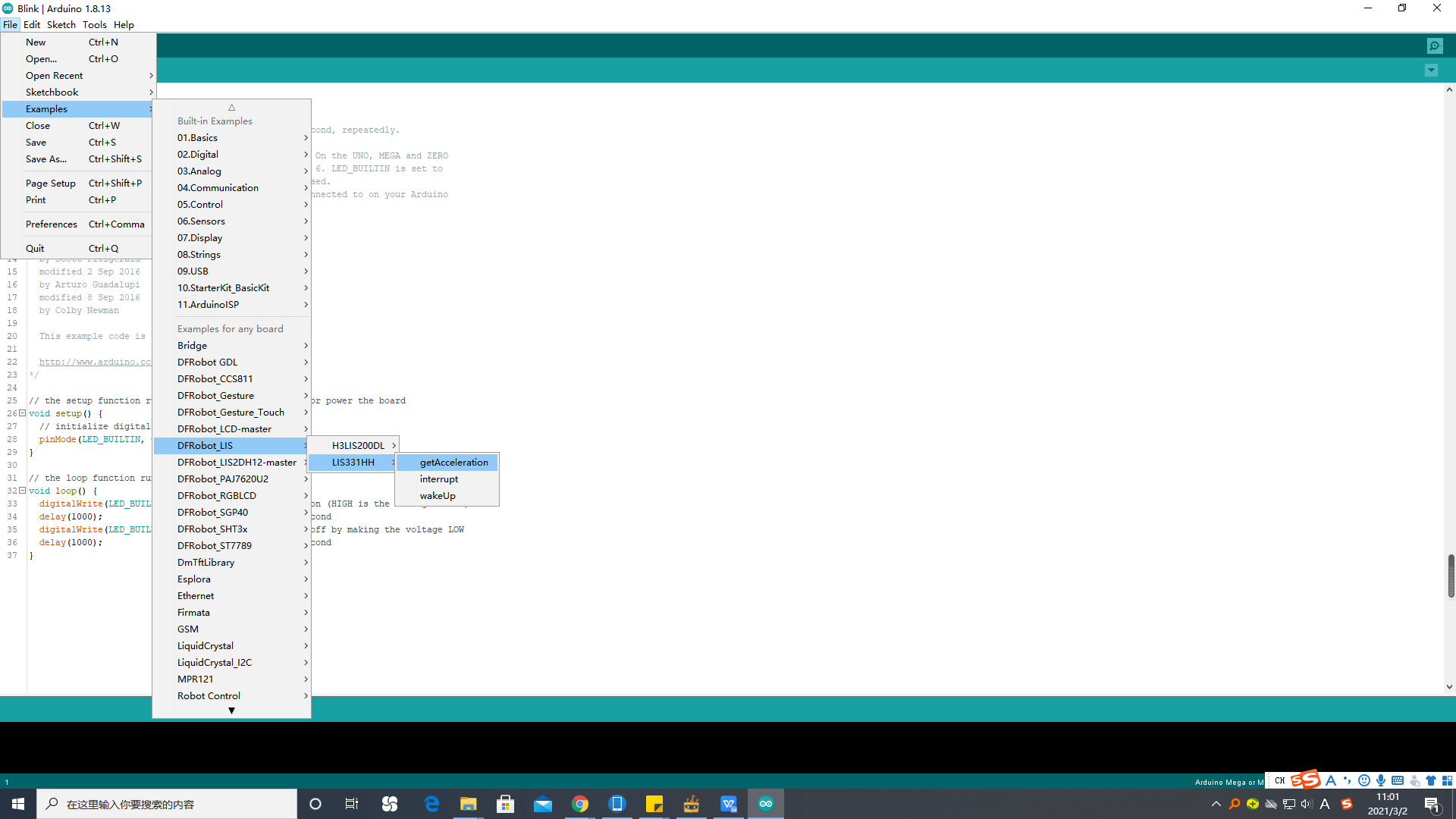
- Program Burning
/**!
* @file getAcceleration.ino
* @brief Get the acceleration in the three directions of xyz, the range can be ±6g, ±12g or ±24g
* @n When using SPI, chip select pin can be modified by changing the value of LIS331HH_CS
* @copyright Copyright (c) 2010 DFRobot Co.Ltd (http://www.dfrobot.com)
* @licence The MIT License (MIT)
* @author [fengli]([email protected])
* @version V1.0
* @date 2021-01-16
* @get from https://www.dfrobot.com
* @https://github.com/DFRobot/DFRobot_LIS
*/
#include <DFRobot_LIS.h>
//When using I2C communication, use the following program to construct an object by DFRobot_LIS331HH_I2C
/*!
* @brief Constructor
* @param pWire I2c controller
* @param addr I2C address(0x18/0x19)
*/
//DFRobot_LIS331HH_I2C acce(&Wire,0x18);
DFRobot_LIS331HH_I2C acce;
//When using SPI communication, use the following program to construct an object by DFRobot_LIS331HH_SPI
#if defined(ESP32) || defined(ESP8266)
#define LIS331HH_CS D3
#elif defined(__AVR__) || defined(ARDUINO_SAM_ZERO)
#define LIS331HH_CS 3
#elif (defined NRF5)
#define LIS331HH_CS 2 //The pin on the development board with the corresponding silkscreen printed as P2
#endif
/*!
* @brief Constructor
* @param cs : Chip selection pinChip selection pin
* @param spi :SPI controller
*/
//DFRobot_LIS331HH_SPI acce(/*cs = */LIS331HH_CS,&SPI);
//DFRobot_LIS331HH_SPI acce(/*cs = */LIS331HH_CS);
void setup(void){
Serial.begin(9600);
//Chip initialization
while(!acce.begin()){
delay(1000);
Serial.println("Initialization failed, please check the connection and I2C address setting");
}
//Get chip id
Serial.print("chip id : ");
Serial.println(acce.getID(),HEX);
/**
set range:Range(g)
eLis331hh_6g = 6,/<±6g>/
eLis331hh_12g = 12,/<±12g>/
eLis331hh_24g = 24/<±24g>/
*/
acce.setRange(/*range = */DFRobot_LIS::eLis331hh_6g);
/**
Set data measurement rate:
ePowerDown_0HZ = 0,
eLowPower_halfHZ,
eLowPower_1HZ,
eLowPower_2HZ,
eLowPower_5HZ,
eLowPower_10HZ,
eNormal_50HZ,
eNormal_100HZ,
eNormal_400HZ,
eNormal_1000HZ,
*/
acce.setAcquireRate(/*rate = */DFRobot_LIS::eNormal_50HZ);
Serial.print("Acceleration:\n");
delay(1000);
}
void loop(void){
//Get the acceleration in the three directions of xyz
//The mearsurement range can be ±6g, ±12g or ±24g, set by the setRange() function
long ax,ay,az;
ax = acce.readAccX();//Get the acceleration in the x direction
ay = acce.readAccY();//Get the acceleration in the y direction
az = acce.readAccZ();//Get the acceleration in the z direction
//acce.getAcceFromXYZ(/*accx = */ax,/*accy = */ay,/*accz = */az);//The second way to obtain acceleration in three directions
Serial.print("x: "); //print acceleration
Serial.print(ax);
Serial.print(" mg \ty: ");
Serial.print(ay);
Serial.print(" mg \tz: ");
Serial.print(az);
Serial.println(" mg");
delay(300);
}
- Result
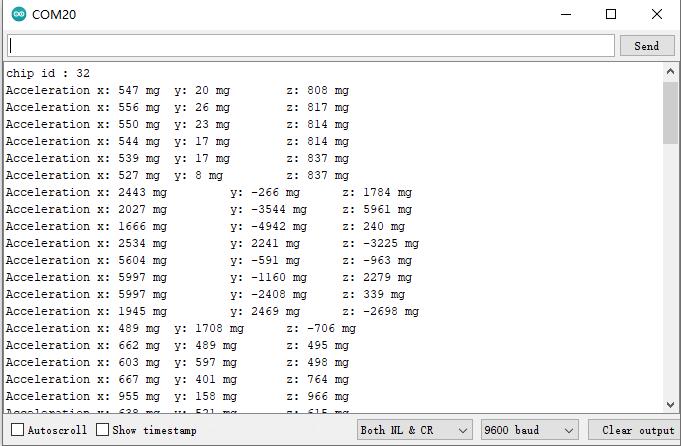
Sample code 2-Wakeup Function(wakeup.ino) (Only available for Breakout Version)
- Select wakeUp.ino
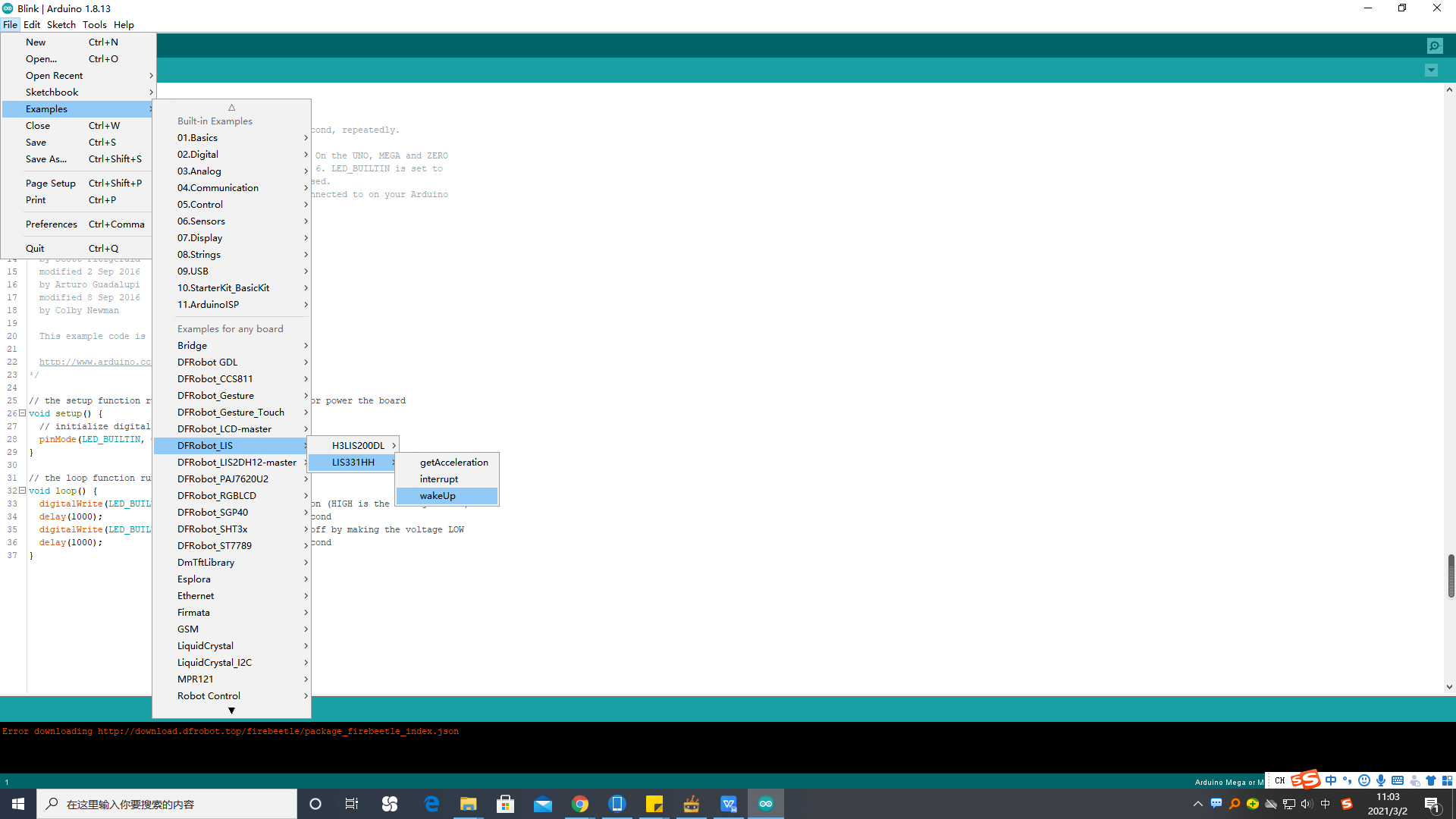
- Program Burning
/**!
* @file wakeUp.ino
* @brief Use wake-up function
* @n Phenomenon: To use this function, you need to turn the module into low-power mode first, and the measurement rate will be
* @n very slow at this time. When an interrupt event set up before occurs, the module will enter normal mode, in which the measurement rate
* @n will be accelerated to save power and provide sampling rate.
* @n When using SPI, chip select pin can be modified by changing the value of macro LIS331HH_CS
* @n This example needs to connect the int2/int1 pin of the module to the interrupt pin of the motherboard. Default UNO(2),
* @n Mega2560(2), Leonardo(3), microbit(P0),FireBeetle-ESP8266(D6),FireBeetle-ESP32((D6),FireBeetle-M0(6)
* @copyright Copyright (c) 2010 DFRobot Co.Ltd (http://www.dfrobot.com)
* @licence The MIT License (MIT)
* @author [fengli]([email protected])
* @version V1.0
* @date 2021-01-16
* @get from https://www.dfrobot.com
* @https://github.com/DFRobot/DFRobot_LIS
*/
#include <DFRobot_LIS.h>
//When using I2C communication, use the following program to construct an object by DFRobot_LIS331HH_I2C
/*!
* @brief Constructor
* @param pWire I2c controller
* @param addr I2C address(0x18/0x19)
*/
//DFRobot_LIS331HH_I2C acce(&Wire,0x18);
DFRobot_LIS331HH_I2C acce;
//When using SPI communication, use the following program to construct an object by DFRobot_LIS331HH_SPI
#if defined(ESP32) || defined(ESP8266)
#define LIS331HH_CS D3
#elif defined(__AVR__) || defined(ARDUINO_SAM_ZERO)
#define LIS331HH_CS 3
#elif (defined NRF5)
#define LIS331HH_CS 2 //The pin on the development board with the corresponding silkscreen printed as P2
#endif
/*!
* @brief Constructor
* @param cs : Chip selection pinChip selection pin
* @param spi :SPI controller
*/
//DFRobot_LIS331HH_SPI acce(/*cs = */LIS331HH_CS,&SPI);
//DFRobot_LIS331HH_SPI acce(/*cs = */LIS331HH_CS);
//Interrupt generation flag
volatile bool intFlag = false;
void interEvent(){
intFlag = true;
acce.setSleepFlag(false);
}
void setup(void){
Serial.begin(9600);
//Chip initialization
while(!acce.begin()){
delay(1000);
Serial.println("Initialization failed, please check the connection or I2C address setting");
}
//Get chip id
Serial.print("chip id : ");
Serial.println(acce.getID(),HEX);
/**
set range:Range(g)
eLis331hh_6g = 6,/<±6g>/
eLis331hh_12g = 12,/<±12g>/
eLis331hh_24g = 24/<±24g>/
*/
acce.setRange(/*range = */DFRobot_LIS::eLis331hh_6g);
/**
Set data measurement rate:
ePowerDown_0HZ = 0,
eLowPower_halfHZ,
eLowPower_1HZ,
eLowPower_2HZ,
eLowPower_5HZ,
eLowPower_10HZ,
eNormal_50HZ,
eNormal_100HZ,
eNormal_400HZ,
eNormal_1000HZ,
*/
// “sleep to wake-up” need to put the chip in low power mode first
acce.setAcquireRate(/*Rate = */DFRobot_LIS::eLowPower_halfHZ);
/**
Set the threshold of interrupt source 1 interrupt
threshold:Threshold(g)
*/
acce.setInt1Th(/*Threshold = */2);
//Enable sleep wake function
acce.enableSleep(true);
/*!
Enable interrupt
Interrupt pin selection:
eINT1 = 0,/<int1 >/
eINT2,/<int2>/
Interrupt event selection:
eXLowThanTh,/<The acceleration in the x direction is less than the threshold>/
eXHigherThanTh ,/<The acceleration in the x direction is greater than the threshold>/
eYLowThanTh,/<The acceleration in the y direction is less than the threshold>/
eYHigherThanTh,/<The acceleration in the y direction is greater than the threshold>/
eZLowThanTh,/<The acceleration in the z direction is less than the threshold>/
eZHigherThanTh,/<The acceleration in the z direction is greater than the threshold>/
*/
acce.enableInterruptEvent(/*int pin*/DFRobot_LIS::eINT1,
/*interrupt = */DFRobot_LIS::eXHigherThanTh);
#if defined(ESP32) || defined(ESP8266)
//The D6 pin is used as the interrupt pin by default, and other non-conflicting pins can also be selected as the external interrupt pin.
attachInterrupt(digitalPinToInterrupt(D6)/*Query the interrupt number of the D6 pin*/,interEvent,CHANGE);
#elif defined(ARDUINO_SAM_ZERO)
//The pin 5 is used as the interrupt pin by default, and other non-conflicting pins can also be selected as the external interrupt pin.
attachInterrupt(digitalPinToInterrupt(5)/*Query the interrupt number of the pin 5*/,interEvent,CHANGE);
#else
/* The Correspondence Table of AVR Series Arduino Interrupt Pins And Terminal Numbers
* ---------------------------------------------------------------------------------------
* | | DigitalPin | 2 | 3 | |
* | Uno, Nano, Mini, other 328-based |--------------------------------------------|
* | | Interrupt No | 0 | 1 | |
* |-------------------------------------------------------------------------------------|
* | | Pin | 2 | 3 | 21 | 20 | 19 | 18 |
* | Mega2560 |--------------------------------------------|
* | | Interrupt No | 0 | 1 | 2 | 3 | 4 | 5 |
* |-------------------------------------------------------------------------------------|
* | | Pin | 3 | 2 | 0 | 1 | 7 | |
* | Leonardo, other 32u4-based |--------------------------------------------|
* | | Interrupt No | 0 | 1 | 2 | 3 | 4 | |
* |--------------------------------------------------------------------------------------
*/
/* The Correspondence Table of micro:bit Interrupt Pins And Terminal Numbers
* ---------------------------------------------------------------------------------------------------------------------------------------------
* | micro:bit | DigitalPin |P0-P20 can be used as an external interrupt |
* | (When using as an external interrupt, |---------------------------------------------------------------------------------------------|
* |no need to set it to input mode with pinMode)|Interrupt No|Interrupt number is a pin digital value, such as P0 interrupt number 0, P1 is 1 |
* |-------------------------------------------------------------------------------------------------------------------------------------------|
*/
attachInterrupt(/*Interrupt No*/0,interEvent,CHANGE);//Enable the external interrupt 0, connect INT1/2 to the digital pin of the main control:
//UNO(2), Mega2560(2), Leonardo(3), microbit(P0).
#endif
}
void loop(void){
//Get the acceleration in the three directions of xyz
//The mearsurement range is ±6g, ±12g or ±24g, set by the setRange() function
//If the chip is awakened, you can see a change in the frequency of data acquisition
Serial.print("Acceleration x: ");
Serial.print(acce.readAccX());
Serial.print(" mg \ty: ");
Serial.print(acce.readAccY());
Serial.print(" mg \tz: ");
Serial.print(acce.readAccZ());
Serial.println(" mg");
if(intFlag == true){
/**
Get whether the sensor is in sleep mode
true(In sleep mode)/false(In normal mode)
*/
Serial.println(acce.getSleepState()? "sleep mode": "normal mode");
intFlag = 0;
}
delay(300);
}
Sample code 3-External Interrupt Function(interrupt.ino) (Only available for breakout version)
-
Select interrupt.ino
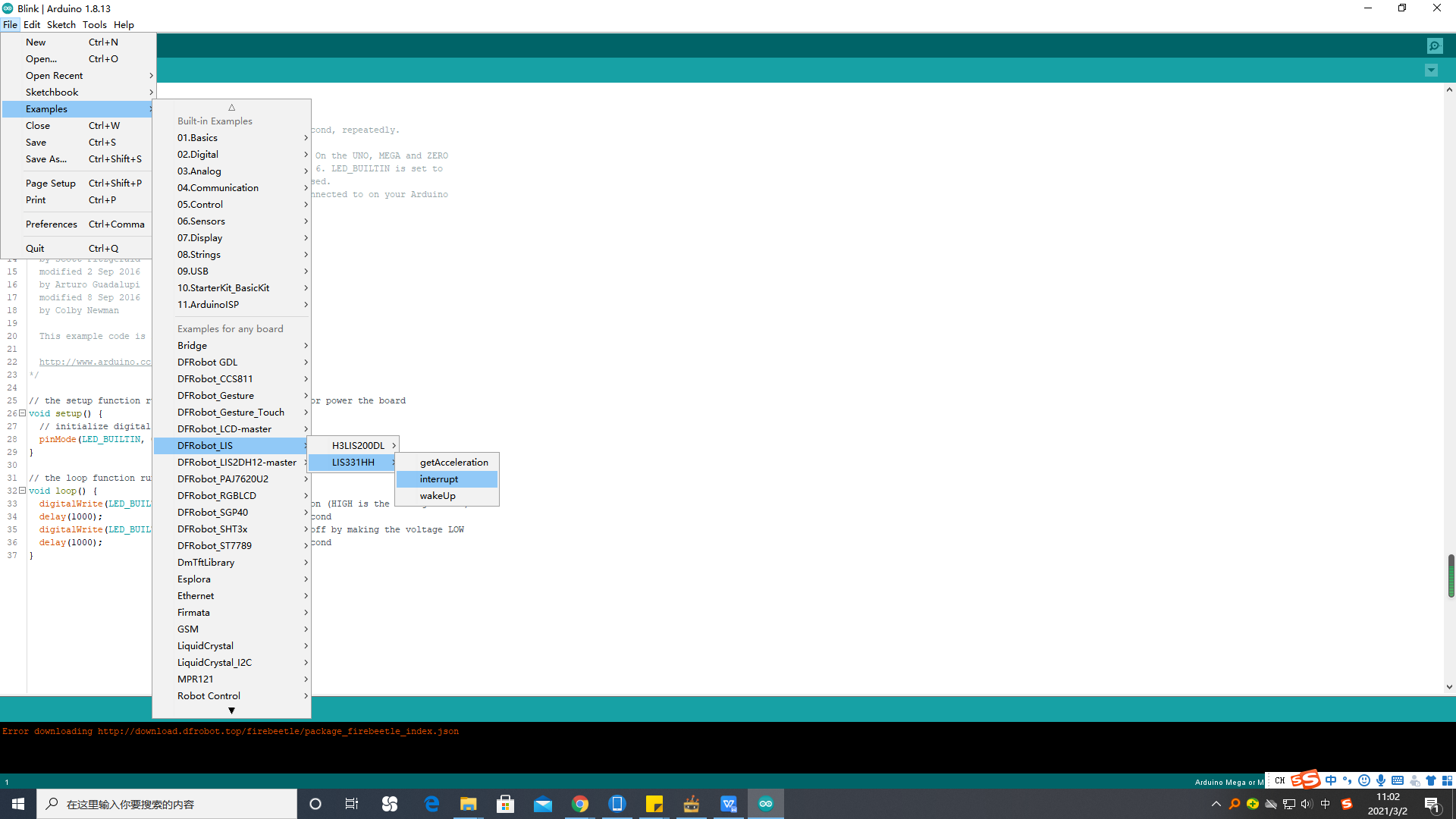
-
Program Burning
/**!
* @file interrupt.ino
* @brief Interrupt detection
* @n In this example, the enable eZHigherThanTh interrupt event means when the acceleration in the Z direction exceeds the
* @n the threshold set by the program, the interrupt level can be detected on the interrupt pin int1/int2 we set, and the level change
* @n on the interrupt pin can be used to determine whether the interrupt occurs. The following are the 6 settable interrupt events:
* @n eXHigherThanTh, eXLowerThanTh, eYHigherThanTh, eYLowerThanTh, eZHigherThanTh,eZLowerThanTh.
* @n For a detailed explanation of each of them, please look up the comments of the enableInterruptEvent() function.
* @n This example needs to connect the int2/int1 pin of the module to the interrupt pin of the motherboard. Default UNO(2),
* @n Mega2560(2), Leonardo(3), microbit(P0),FireBeetle-ESP8266(D6),FireBeetle-ESP32((D6),FireBeetle-M0(6)
* @copyright Copyright (c) 2010 DFRobot Co.Ltd (http://www.dfrobot.com)
* @licence The MIT License (MIT)
* @author [fengli]([email protected])
* @version V1.0
* @date 2021-01-16
* @get from https://www.dfrobot.com
* @https://github.com/DFRobot/DFRobot_LIS
*/
#include <DFRobot_LIS.h>
//When using I2C communication, use the following program to construct an object by DFRobot_LIS331HH_I2C
/*!
* @brief Constructor
* @param pWire I2c controller
* @param addr I2C address(0x18/0x19)
*/
//DFRobot_LIS331HH_I2C acce(&Wire,0x18);
DFRobot_LIS331HH_I2C acce;
//When using SPI communication, use the following program to construct an object by DFRobot_LIS331HH_SPI
#if defined(ESP32) || defined(ESP8266)
#define LIS331HH_CS D3
#elif defined(__AVR__) || defined(ARDUINO_SAM_ZERO)
#define LIS331HH_CS 3
#elif (defined NRF5)
#define LIS331HH_CS 2 //The pin on the development board with the corresponding silkscreen printed as P2
#endif
/*!
* @brief Constructor
* @param cs Chip selection pinChip selection pin
* @param spi SPI controller
*/
//DFRobot_LIS331HH_SPI acce(/*cs = */LIS331HH_CS,&SPI);
//DFRobot_LIS331HH_SPI acce(/*cs = */LIS331HH_CS);
volatile uint8_t intFlag = 0;
void interEvent(){
intFlag = 1;
}
void setup(void){
Serial.begin(9600);
//Chip initialization
while(!acce.begin()){
delay(1000);
Serial.println("Initialization failed, please check the connection and I2C address setting");
}
Serial.print("chip id : ");
Serial.println(acce.getID(),HEX);
/**
set range:Range(g)
eLis331hh_6g = 6,/<±6g>/
eLis331hh_12g = 12,/<±12g>/
eLis331hh_24g = 24/<±24g>/
*/
acce.setRange(/*range = */DFRobot_LIS::eLis331hh_6g);
/**
Set data measurement rate:
ePowerDown_0HZ = 0,
eLowPower_halfHZ,
eLowPower_1HZ,
eLowPower_2HZ,
eLowPower_5HZ,
eLowPower_10HZ,
eNormal_50HZ,
eNormal_100HZ,
eNormal_400HZ,
eNormal_1000HZ,
*/
acce.setAcquireRate(/*rate = */DFRobot_LIS::eLowPower_2HZ);
#if defined(ESP32) || defined(ESP8266)
//The D6 pin is used as the interrupt pin by default, and other non-conflicting pins can also be selected as the external interrupt pin.
attachInterrupt(digitalPinToInterrupt(D6)/*Query the interrupt number of the D6 pin*/,interEvent,CHANGE);
#elif defined(ARDUINO_SAM_ZERO)
//The pin 5 is used as the interrupt pin by default, and other non-conflicting pins can also be selected as the external interrupt pin.
attachInterrupt(digitalPinToInterrupt(5)/*Query the interrupt number of the pin 5*/,interEvent,CHANGE);
#else
/* The Correspondence Table of AVR Series Arduino Interrupt Pins And Terminal Numbers
* ---------------------------------------------------------------------------------------
* | | DigitalPin | 2 | 3 | |
* | Uno, Nano, Mini, other 328-based |--------------------------------------------|
* | | Interrupt No | 0 | 1 | |
* |-------------------------------------------------------------------------------------|
* | | Pin | 2 | 3 | 21 | 20 | 19 | 18 |
* | Mega2560 |--------------------------------------------|
* | | Interrupt No | 0 | 1 | 2 | 3 | 4 | 5 |
* |-------------------------------------------------------------------------------------|
* | | Pin | 3 | 2 | 0 | 1 | 7 | |
* | Leonardo, other 32u4-based |--------------------------------------------|
* | | Interrupt No | 0 | 1 | 2 | 3 | 4 | |
* |--------------------------------------------------------------------------------------
*/
/* The Correspondence Table of micro:bit Interrupt Pins And Terminal Numbers
* ---------------------------------------------------------------------------------------------------------------------------------------------
* | micro:bit | DigitalPin |P0-P20 can be used as an external interrupt |
* | (When using as an external interrupt, |---------------------------------------------------------------------------------------------|
* |no need to set it to input mode with pinMode)|Interrupt No|Interrupt number is a pin digital value, such as P0 interrupt number 0, P1 is 1 |
* |-------------------------------------------------------------------------------------------------------------------------------------------|
*/
attachInterrupt(/*Interrupt No*/0,interEvent,CHANGE);//Open the external interrupt 0, connect INT1/2 to the digital pin of the main control:
//UNO(2), Mega2560(2), Leonardo(3), microbit(P0).
#endif
/**
Set the threshold of interrupt source 1 interrupt
threshold:Threshold(g)
*/
acce.setInt1Th(/*Threshold = */2);
/*!
Enable interrupt
Interrupt pin selection:
eINT1 = 0,/<int1 >/
eINT2,/<int2>/
Interrupt event selection:
eXLowerThanTh ,/<The acceleration in the x direction is less than the threshold>/
eXHigherThanTh ,/<The acceleration in the x direction is greater than the threshold>/
eYLowerThanTh,/<The acceleration in the y direction is less than the threshold>/
eYHigherThanTh,/<The acceleration in the y direction is greater than the threshold>/
eZLowerThanTh,/<The acceleration in the z direction is less than the threshold>/
eZHigherThanTh,/<The acceleration in the z direction is greater than the threshold>/
*/
acce.enableInterruptEvent(/*int pin*/DFRobot_LIS::eINT1,/*interrupt = */DFRobot_LIS::eZHigherThanTh);
delay(1000);
}
void loop(void){
//Get the acceleration in the three directions of xyz
//The mearsurement range is ±6g, ±12g or ±24g, set by the setRange() function
Serial.print("Acceleration x: ");
Serial.print(acce.readAccX());
Serial.print(" mg \ty: ");
Serial.print(acce.readAccY());
Serial.print(" mg \tz: ");
Serial.print(acce.readAccZ());
Serial.println(" mg");
if(intFlag == 1){
//Check whether the interrupt event is generated in int1
if(acce.getInt1Event(DFRobot_LIS::eYHigherThanTh)){
Serial.println("The acceleration in the y direction is greater than the threshold");
}
if(acce.getInt1Event(DFRobot_LIS::eZHigherThanTh)){
Serial.println("The acceleration in the z direction is greater than the threshold");
}
if(acce.getInt1Event(DFRobot_LIS::eXHigherThanTh)){
Serial.println("The acceleration in the x direction is greater than the threshold");
}
intFlag = 0;
}
delay(300);
}
Tutorial for Raspberry Pi
Requirements
-
Hardware
- Raspberry Pi 4B(or similar) x 1
- LIS331HH Triple Axis Accelerometer x1
- Jumper wires x1
-
Software
- Download and install the LIS Series Python Library.
- Raspberry Pi Official OS
Connection
- Connect the module to the Raspberry Pi according to the connection diagram. The default I2C address is 0x19.
Driver Installtion
- Enable the I2C interface of the Raspberry Pi. If it is already enabled, you can skip this step. Open Terminal, type the following command, and press Enter:
sudo raspi-config
Then use the up and down keys to select "5 Interfacing Options", press Enter, select "P5 I2C", and press Enter to confirm "YES". Restart the Raspberry Pi main control board.
- To install Python dependent libraries and git, the Raspberry Pi needs to be connected to the Internet. If it is already installed, you can skip this step. In the terminal, type the following commands in sequence, and press Enter:
sudo apt-get update
sudo apt-get install build-essential python-dev python-smbus git
- Download the LIS series driver library. In the terminal, type the following commands in sequence and press Enter:
git clone https://github.com/DFRobot/DFRobot_LIS
Sample Code
- Sample code 1-Read acceleration of x, y and z(get_acceleration.py)
- Sample code 2-Wakeup function(wake_up.py) (Only available for Breakout Version)
- Sample code 3-External Interrupt Function(interrupt.py) (Only available for breakout version)
Sample code 1-Read acceleration of x, y and z(get_acceleration.py)
- In the terminal, type the following command and press Enter, run the sample code:
DFRobot_LIS/tree/master/python/raspberrypi/examples/LIS331HH
cd get_acceleration
python get_acceleration.py
- Result
Shake the sensor, the following result will appear.

- Note: If the situation as shown in the picture below appears, please check whether the I2C address is correct.

Sample code 2-Wakeup function(wake_up.py) (Only available for Breakout Version)
- In the terminal, type the following command and press Enter, run the sample code:
DFRobot_LIS/tree/master/python/raspberrypi/examples/LIS331HH
cd wake_up
python wake_up.py
Sample code 3-External Interrupt Function(interrupt.py) (Only available for breakout version)
- In the terminal, type the following command and press Enter, run the sample code:
DFRobot_LIS/tree/master/python/raspberrypi/examples/LIS331HH
cd interrupt
python interrupt.py
FAQ
For any questions, advice or cool ideas to share, please visit the DFRobot Forum.

